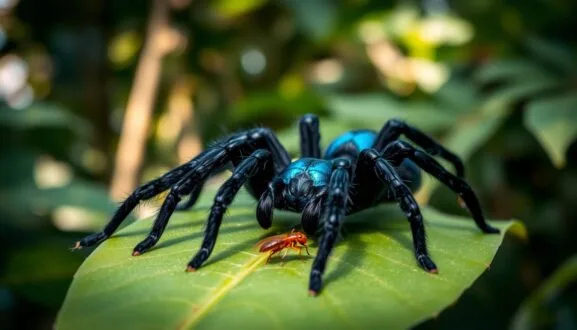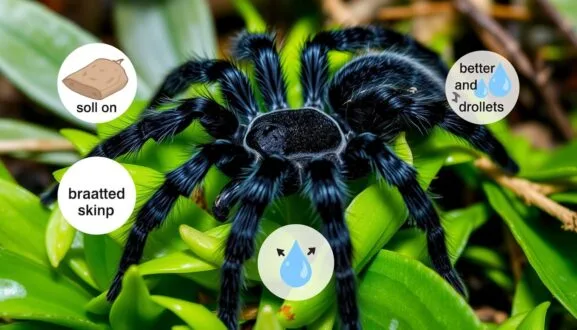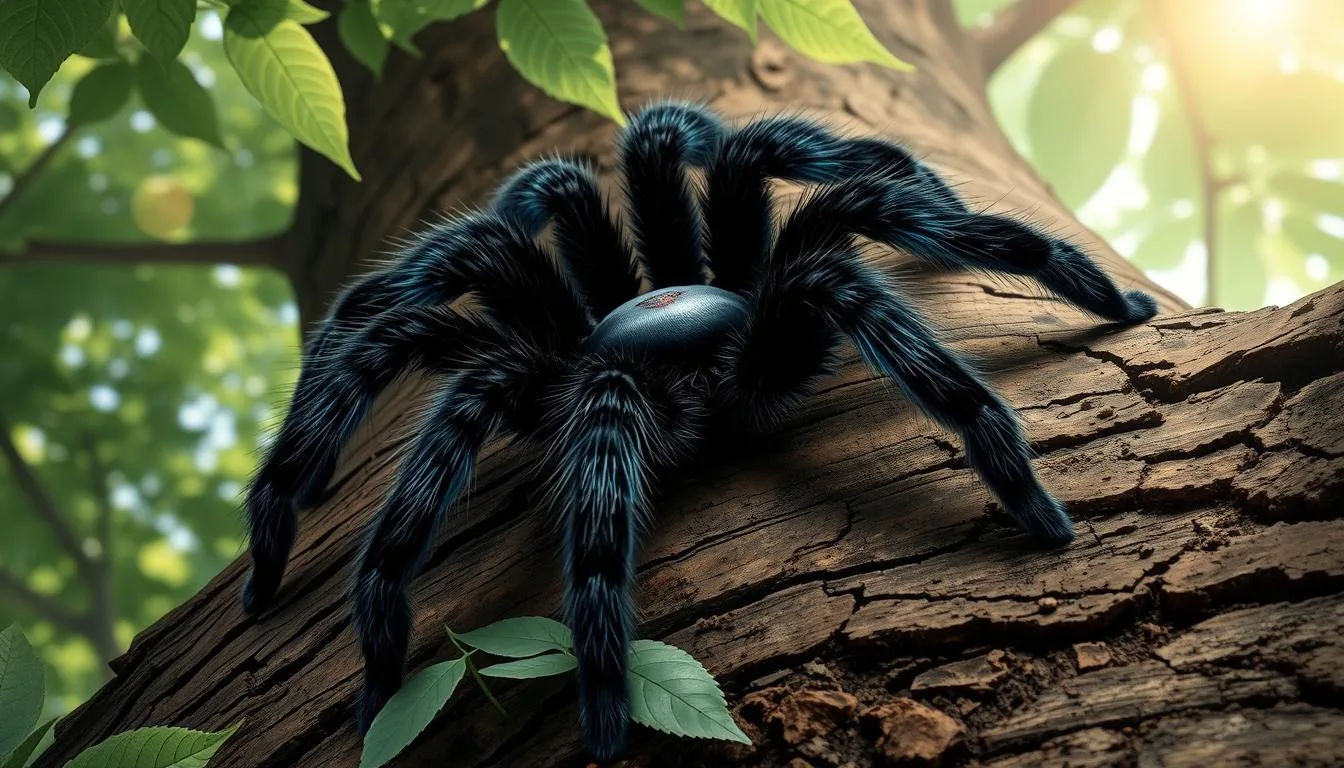Welcome to your guide on the Brazilian black tarantula. This amazing arachnid is one of the most captivating tarantula species. You’ll learn about its unique behaviors and what makes it special.
In this article, you’ll discover its natural habitat and physical traits. You’ll also learn how to care for it as a pet. Get ready to explore the fascinating life of the Brazilian black tarantula.
- Introduction to the Brazilian Black Tarantula
- Physical Characteristics and Appearance
- Natural Habitat and Distribution
- Hunting and Feeding Behavior
- Life Cycle and Reproduction
- Brazilian Black Tarantula as a Pet
- Housing and Care Requirements
- Common Health Issues and Solutions
- Interaction with Humans
- Conservation Status and Threats
- Conclusion: Understanding Your Brazilian Black Tarantula
- FAQ:
- How venomous is a Brazilian black tarantula?
- Is the Brazilian black tarantula friendly?
- Are black tarantulas aggressive?
- How big does a Brazilian black tarantula get?
- What is the most aggressive tarantula?
- Which tarantula has the worst bite?
- What eats a black tarantula?
- What is the world's largest tarantula?
- What is the safest tarantula?
Introduction to the Brazilian Black Tarantula
The Brazilian Black Tarantula, known as Grammostola pulchra, is a unique arachnid. It is known for its striking looks and calm nature. Learning about its classification helps us understand its special traits and behaviors.
Species Classification
Grammostola pulchra is part of the Theraphosidae family. This family includes many large tarantulas. Here’s how it fits into the arachnid world:
| Kingdom | Animalia |
|---|---|
| Phylum | Arthropoda |
| Class | Chelicerata |
| Order | Araneae |
| Family | Theraphosidae |
| Genus | Grammostola |
| Species | G. pulchra |
Natural History
The evolution of Grammostola pulchra is fascinating. It has adapted well to different environments. Its strong body and sensory hairs help it move and hunt, making it interesting to arachnid fans.
Significance in Arachnology
This tarantula is key in arachnology. It helps scientists learn about arachnid behavior and their role in ecosystems. Research on Grammostola pulchra expands our understanding of spider diversity and how they adapt.
Physical Characteristics and Appearance
The Brazilian Black Tarantula has a striking appearance that fascinates many. It can grow up to 5 inches in leg span. Its sleek, jet-black exoskeleton makes it stand out.
Its black color not only looks intimidating but also helps it blend in with its surroundings. This tarantula has eight strong legs. Each leg ends in sharp claws, perfect for climbing and catching prey.
- Size: Up to 5 inches in leg span
- Coloration: Deep black exoskeleton
- Leg Arrangement: Eight strong, agile legs
- Distinctive Features: Prominent fangs and muscular body
The exoskeleton protects and supports the tarantula, allowing it to move freely. It’s essential for survival, offering defense and a base for muscles.
| Characteristic | Description |
|---|---|
| Leg Span | Up to 5 inches |
| Color | Jet black exoskeleton |
| Body Structure | Robust and muscular with prominent fangs |
| Exoskeleton | Protective and flexible for movement |
Natural Habitat and Distribution
The Brazilian Black Tarantula lives in many places across South America. Knowing where they live helps us see how they fit into their world.
Geographic Range
This spider is mostly found in Brazil. It also lives in Paraguay and Argentina. Each place has its own special conditions that help the spider survive.
Preferred Environment
The Brazilian Black Tarantula loves warm places with some moisture. It thrives in dense forests and areas with lots of plants. These places give it the cover and stability it needs to live well.
Microhabitat Requirements
Inside its big habitat, this tarantula needs certain small places to live. It likes underground burrows or hidden spots. These places keep it safe from dangers and harsh weather, helping it grow and have babies.
| Aspect | Description |
|---|---|
| Geographic Range | Brazil, Paraguay, Argentina |
| Climate | Warm with moderate humidity |
| Vegetation | Dense forests and ample plant life |
| Microhabitats | Underground burrows, sheltered crevices |
Hunting and Feeding Behavior

Learning about the Brazilian Black Tarantula’s hunting and feeding habits is fascinating. It shows how they survive and thrive. You’ll appreciate their skill in catching food.
Their diet mainly includes insects, small spiders, and other tiny arthropods. This variety ensures they get all the nutrients they need.
Brazilian Black Tarantulas are expert ambush predators. They wait patiently for prey to come close. Then, they strike quickly with their strong legs.
Silk is key in their hunting. They use it to create draglines. These help them sense vibrations and stay steady during attacks.
Venom is crucial for catching prey. After catching something, they inject venom to paralyze it. This makes digestion easier and helps them get the most nutrients.
| Prey Type | Spider Hunting Technique |
|---|---|
| Insects | Ambush and swift capture |
| Small Spiders | Stealthy approach and venom injection |
| Arthropods | Use of silk draglines for stability |
Life Cycle and Reproduction
Exploring the spider life cycle of the Brazilian Black Tarantula reveals a captivating journey. It goes from egg to adult, filled with growth and behavior changes.
Mating Rituals
During tarantula reproduction, males do special dances to win over females. These dances help them avoid being seen as food. It’s a big challenge for males to successfully mate.
Egg Sac Development
After mating, females make an egg sac. They guard it carefully to keep the eggs safe. This protection is crucial for the spiderlings’ survival until they’re ready to go out on their own.
Growth Stages
The arachnid molting process lets tarantulas grow. From tiny spiderlings to full-grown adults, each molt helps them get bigger. This growth is key for their long life and ability to reproduce.
| Stage | Description | Duration |
|---|---|---|
| Egg | Laid in an egg sac, protected by the female | 6-8 weeks |
| Spiderling | Emerges from the egg, begins first molt | Varies, multiple molts over months |
| Subadult | Undergoes several molts, gains size and strength | 1-2 years |
| Adult | Reproductive maturity achieved | 3-5 years |
Brazilian Black Tarantula as a Pet
Thinking about getting a pet tarantula? The Brazilian Black Tarantula is a top pick for exotic pets. Its striking looks and interesting behavior make it a hit with arachnid fans.
This tarantula is known for being calm in captivity. This makes it easy for owners to interact with them. They can live up to 25 years, offering a long-term friend.
- Pros:
- Long lifespan
- Low maintenance for arachnid care
- Minimal handling required
- Cons:
- Requires specific humidity levels
- Not suitable for those seeking interactive pets
- Handling can be stressful for the tarantula
The Brazilian Black Tarantula is easy to care for with the right setup. Its beauty and low care needs make it a great choice for exotic pet lovers.
| Aspect | Details |
|---|---|
| Longevity | Up to 25 years |
| Temperament | Calm in captivity |
| Maintenance | Low with proper arachnid care |
| Handling | Minimal required |
Housing and Care Requirements
Creating the right environment is key for your Brazilian black tarantula’s health. Good tarantula care means a happy and healthy pet.
Terrarium Setup
Choose a big spider terrarium for your tarantula to roam. Use coconut fiber or peat moss at the bottom to keep moisture. Add hiding spots like cork bark or hiding caves for safety.
Temperature and Humidity
Keep the temperature between 75-85°F to match their natural home. Use a thermometer to check the terrarium’s temperature. Humidity should be 60-70%. Mist the enclosure lightly a few times a week and ensure good air flow to avoid mold.
Feeding Schedule
Feed your tarantula every 7-10 days with the right food. Give them live insects like crickets, roaches, or mealworms for a balanced diet. Make sure the prey is not too big for your tarantula. Clean up any leftover food to keep the terrarium clean.
Common Health Issues and Solutions
Keeping your Brazilian black tarantula healthy is key. Dehydration is a common problem. Look for signs like lethargy and a shriveled look. Make sure your tarantula always has fresh water.
Mites can also be a problem. Check for tiny specks moving on your tarantula or in its web. Clean the terrarium often and use the right treatments to get rid of mites.
Issues with molting are common too. If your tarantula has trouble shedding, it might get stuck or hurt. Keep the humidity right and don’t disturb it too much during this time.
Good care helps prevent diseases. Make sure your tarantula’s home has the right temperature and humidity. A clean, well-maintained habitat helps keep your tarantula healthy.
If your tarantula keeps getting sick, get help from a vet. Vets who know about arachnids can give the right care and advice. This will help your tarantula stay healthy and happy.

| Health Issue | Signs | Solutions |
|---|---|---|
| Dehydration | Lethargy, shriveled appearance | Provide fresh water regularly |
| Mite Infestation | Tiny moving specks, webbing damage | Clean terrarium, use appropriate treatments |
| Molting Difficulties | Struggles to shed exoskeleton | Maintain proper humidity, reduce disturbances |
Interaction with Humans
Dealing with the Brazilian Black Tarantula needs knowledge and respect. It’s important for both experts and newbies to know how to handle these creatures safely.
Handling Safety
It’s not wise for beginners to handle tarantulas. They can get stressed and act defensively if not handled right.
- Always wash your hands before and after handling.
- Use gentle, slow movements to avoid startling the tarantula.
- Support the spider’s body to prevent falls.
- Limit handling to minimize stress on the tarantula.
Venom Potency
The Brazilian Black Tarantula has venom, but it’s not usually deadly to humans. Still, bites can be very uncomfortable and may cause allergic reactions in some people.
| Aspect | Description |
|---|---|
| Venom Strength | Moderate; mainly used to catch prey. |
| Human Effects | Pain, swelling, and possible allergic reactions. |
| First Aid | Clean the wound, apply ice, and seek medical attention if symptoms persist. |
Conservation Status and Threats
The Brazilian black tarantula is facing big challenges in the wild. It’s one of the endangered arachnids, and their numbers are dropping fast.
Several factors are causing these problems:
- Habitat Loss: Deforestation and urbanization cut down the natural places where these tarantulas live.
- Illegal Collection: The pet trade takes wild specimens, harming local populations.
- Climate Change: Changes in weather patterns make it harder for them to survive and reproduce.
There are efforts to save these amazing creatures. Conservation programs work to keep their habitats safe and control the pet trade. They also promote breeding captive tarantulas to lessen the demand on wild ones.
As a responsible pet owner, you can help by choosing captive-bred tarantulas. Supporting ethical breeders helps protect endangered arachnids for the future.
| Threat | Conservation Action |
|---|---|
| Habitat Loss | Protect and restore natural habitats |
| Illegal Collection | Regulate the pet trade and enforce laws |
| Climate Change | Implement climate adaptation strategies |
Conclusion: Understanding Your Brazilian Black Tarantula
Learning about tarantulas is fascinating. This guide has given you a closer look at the Brazilian black tarantula. You now know more about their unique traits and how they behave.
This knowledge helps you appreciate these spiders more. It also teaches you how to care for them responsibly.
These tarantulas play a big role in nature. By keeping their habitats right and knowing what they need, you help them thrive. This is good for them and the environment too.
Keep learning about arachnids and share what you know. Your work in appreciating and protecting spiders can help save these amazing creatures for the future.
FAQ:
How venomous is a Brazilian black tarantula?
The Brazilian black tarantula has venom that is mild and poses minimal risk to humans. Its bite is comparable to a bee sting, typically causing minor swelling or irritation. Known for its docile temperament, this species rarely bites, making it a safe and popular choice for tarantula enthusiasts and beginners alike.
Is the Brazilian black tarantula friendly?
The Brazilian black tarantula is widely regarded as one of the friendliest tarantula species. Its calm demeanor and tolerance for handling make it a favorite among enthusiasts. With minimal defensive behavior and a gentle nature, this tarantula is an ideal choice for those seeking a low-stress and manageable arachnid companion.
Are black tarantulas aggressive?
The Brazilian black tarantula is known for its exceptionally docile nature, making it one of the least aggressive tarantulas. Unlike some other species, it rarely displays defensive behaviors and is well-suited for handling. Its calm temperament makes it a popular and trusted choice among beginners and experienced keepers alike.
How big does a Brazilian black tarantula get?
The Brazilian black tarantula grows to an impressive leg span of 6 to 8 inches, with a robust, shiny black body that exudes elegance. This medium to large-sized tarantula is admired not only for its striking appearance but also for its manageable size, making it an ideal choice for enthusiasts.
What is the most aggressive tarantula?
The king baboon tarantula is often considered one of the most aggressive tarantulas, known for its defensive behavior and powerful bite. In contrast, the Brazilian black tarantula is celebrated for its calm and gentle demeanor, making it a favorite among enthusiasts seeking a non-aggressive and easy-to-handle species.
Which tarantula has the worst bite?
While most tarantula bites are harmless to humans, the Poecilotheria genus, known as ornamental tarantulas, is reputed to have the most painful bite due to its potent venom. In contrast, the Brazilian black tarantula is known for its docile nature and mild venom, making it far less threatening to handlers.
What eats a black tarantula?
The Brazilian black tarantula faces predators like birds, snakes, and larger mammals in its natural habitat. Additionally, wasps, such as the tarantula hawk, are formidable foes, paralyzing tarantulas to serve as a food source for their larvae. These predators highlight the challenges tarantulas face despite their intimidating appearance.
What is the world’s largest tarantula?
The Goliath birdeater is the world’s largest tarantula, boasting a leg span of up to 12 inches and weighing over 6 ounces. While the Brazilian black tarantula is admired for its docility, the Goliath birdeater is renowned for its sheer size, making it a fascinating species for arachnid enthusiasts.
What is the safest tarantula?
The Brazilian black tarantula is often regarded as one of the safest tarantulas for enthusiasts. Known for its docile temperament and slow movements, it rarely displays aggression. Its calm nature, coupled with minimal venom potency, makes it an ideal choice for beginners and those seeking a low-risk arachnid companion.

